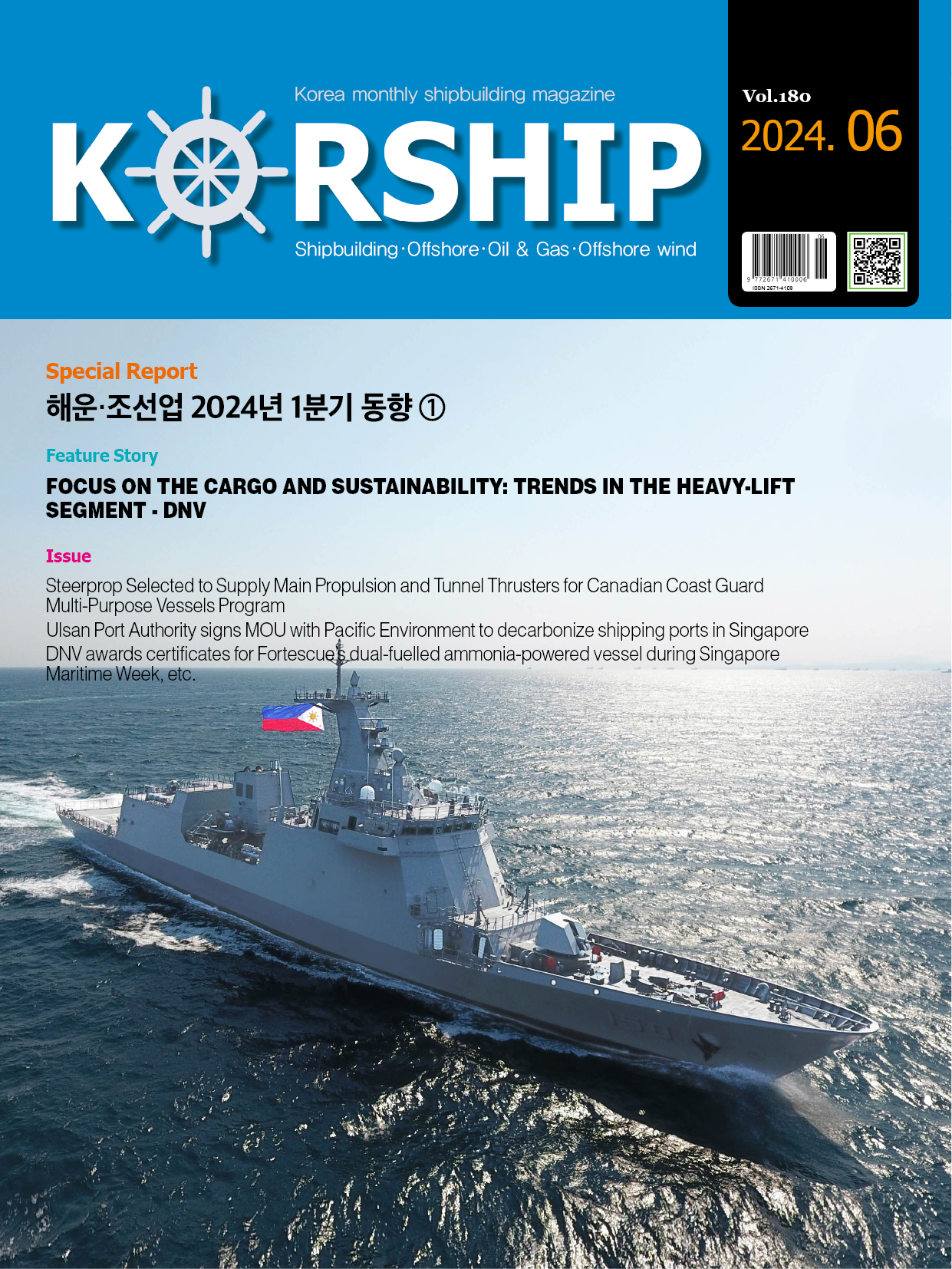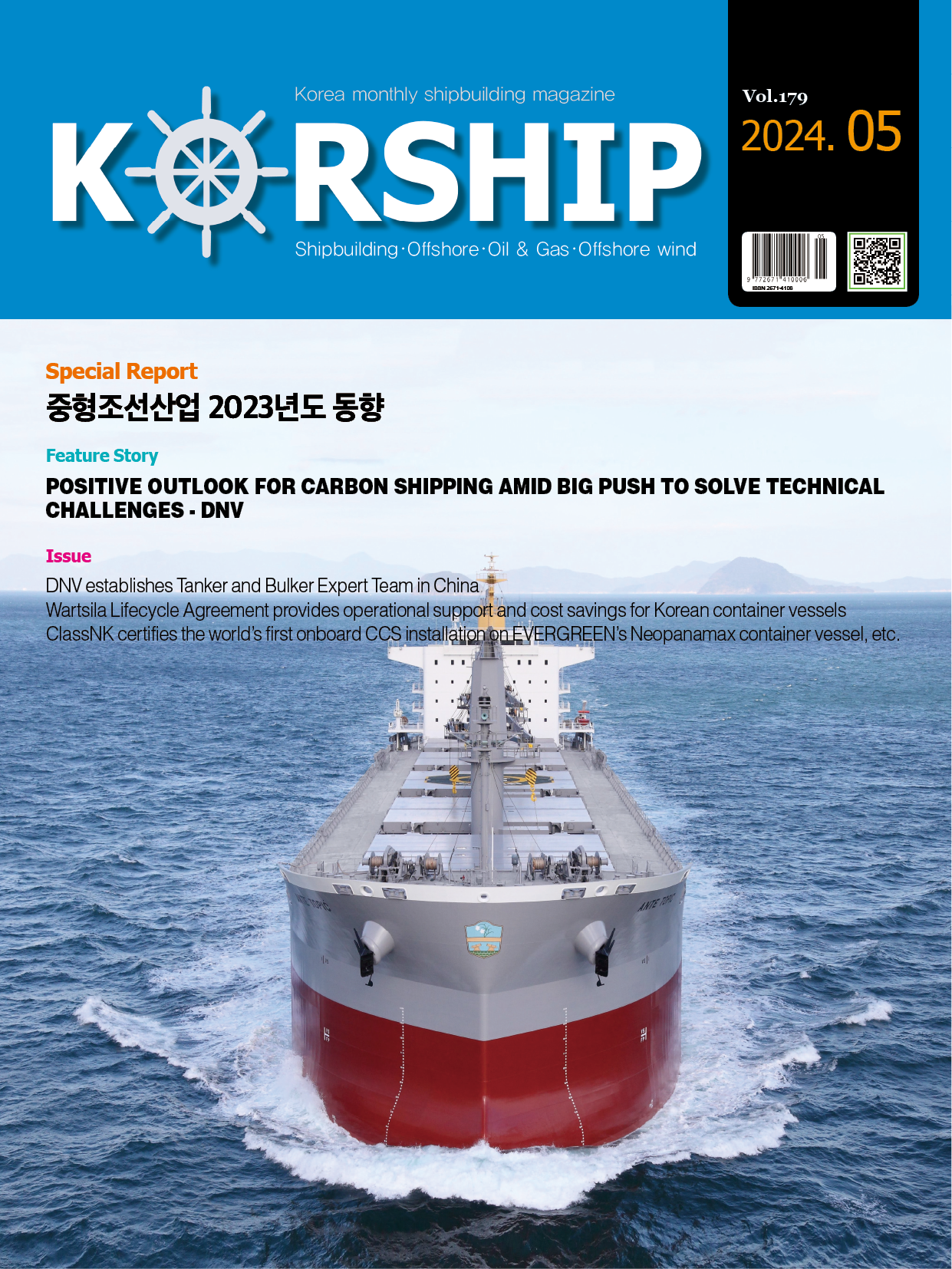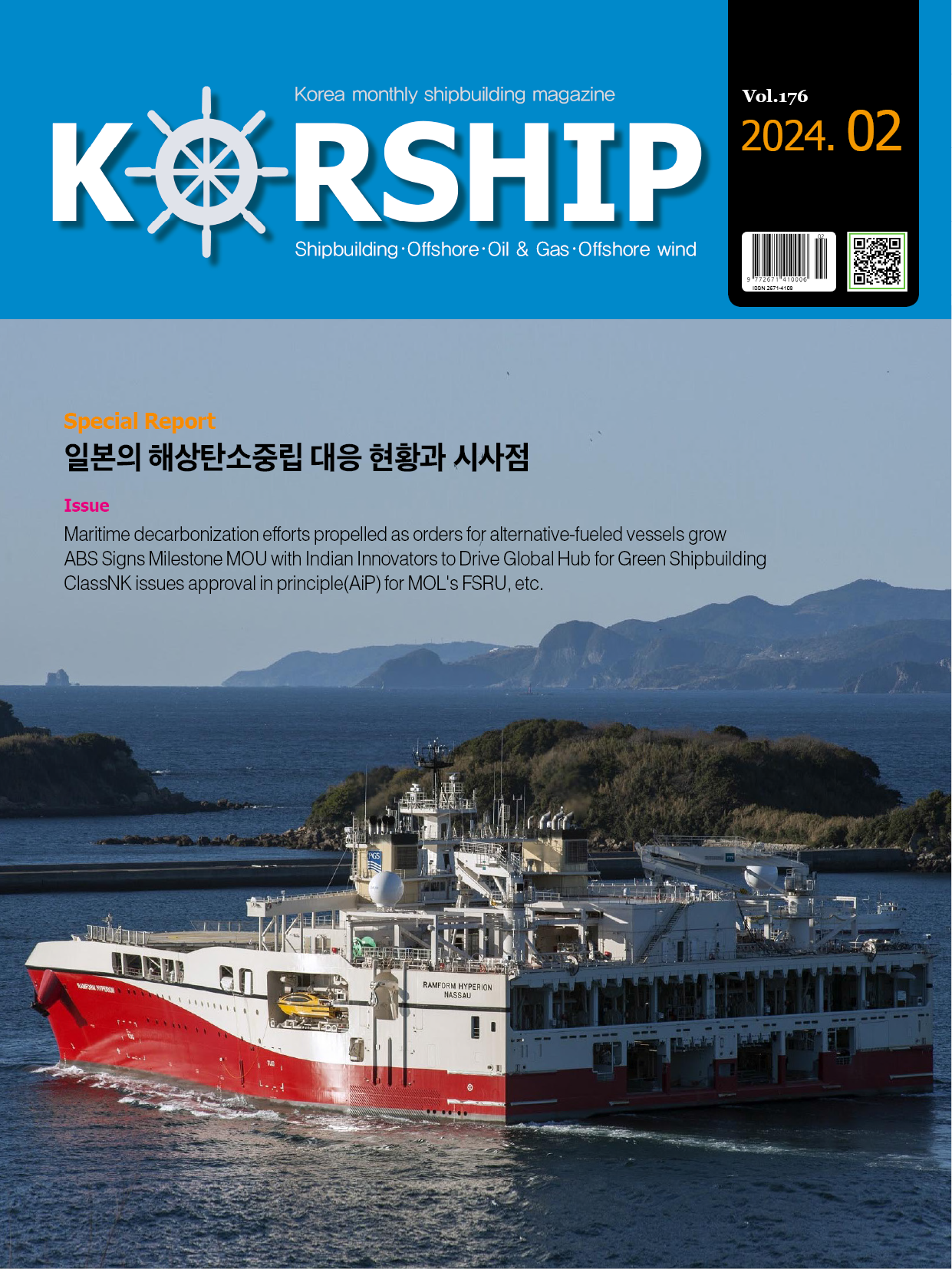Feature Story Development and application of marine robot technology
페이지 정보
작성자 최고관리자 댓글 0건 조회 3,006회 작성일 19-05-24 19:18본문

I. Marine Robot Categorization and Market Size
1. Marine robot categorization
Marine Robots can be largely categorized into manned and unmanned. Unmanned marine robots can be further subdivided into Remotely Operated Vehicles (ROV), which is connected via a cable and communicates with the outside, and Autonomous Underwater Vehicle (AUV), which operates wirelessly and performs its own missions.
2. Marine robot market size
Considering the size of the global marine robot market, over 60% is consumed for military use. Despite developments for civilian use, its proportion is relatively small, and non-military use AUVs are mostly used for research purposes. 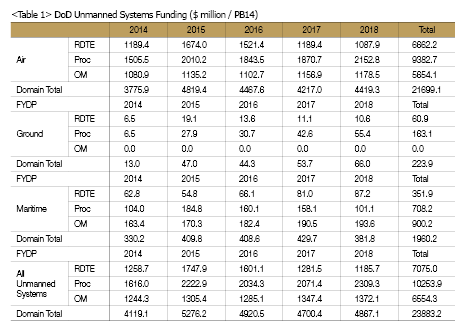
II. Overseas marine robot investment budget and technology development case
1. US Department of Defence marine robot investment budget
Looking at the US Department of Defence’s annual spending budget, they are investing approximately $400 million USD on unmanned systems, annually. Expenditure is largely divided into surface and seabed robot developments, and it is estimated that most investments go towards AUVs.
2. Overseas technology development case
① OceanOne(Stanford University, United States of America)
The humanoid-type ROV uses haptic technology to directly relay feedback from the robot’s arms and can be controlled from a vessel. This is a concept to replace the human diver, and it was developed with the ability to be able to do the same work as a diver, but at deeper depths. It is approximately 150cm long, and has eight propelling units (four for vertical movements and four for horizontal movements).
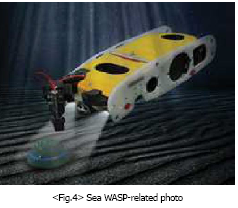
② Sea WASP(SAAB, Sweden)
This ROV was developed with funding from the US Department of Defence based-off of a US Army bomb removal robot, but with the ability to remove sea mines. It is advantageous for sea mine removal as it is equipped with technology to maintain a fixed position. It is 1.7m long and weighs less than 90kg.
③ Eelume(Kongsberg Maritime, Norway)
The Eelime is a snake-shaped robot capable of exploring narrow and hard-to-reach underwater locations. Although a similar robot has been developed, the Eelime has been developed so that it may be used in an actual offshore plant.
④ Dam survey robot(Panasonic, Japan)
This is an underwater robot for dam management in Japan. It can clearly film an inspected area despite murky waters and can also film whilst maintaining a constant height and distance in flowing waters. It has been commercialized and used in Japanese dam facilities for over 20 years.
III. Examples of domestic product development and application
1. Marine science research-use robots
① 6,000m deep sea Remotely Operated Vehicle(ROV) ‘Hae Mi Rae’
The ‘Hae Mi Rae’ is a 6,000m deep sea, unmanned submersible, which is 3.3m long, 1.8m wide, 2.2m high, and weighs 3,660kg. It is controlled by a cable connected to the mother ship’s control room, equipped with eight cameras, 2 robotic arms, and other equipment necessary for exploration.
Throughout June 2015, the ‘Hae Mi Rae’ surveyed eight areas of the East Sea including Wang Dol Cho Gorge, the East Sea Waste Dumping Area, and also undertook the collection of abandoned fishing nets, discovered porous rock cliffs, collected sediment samples, as well as observe and collect samples of seabed organisms. From March to April 2016, the ‘Hae Mi Rae’ surveyed and searched the volcanic areas of the Mariana trench as well as sampling the environment surrounding hydrothermal vents. In specific, sediment collector installation, coring, sediment sampling, and organism collection were undertaken, which has enabled marine biologists to study the geological and biological characteristics of various microorganisms as well as the characteristics of the surounding region.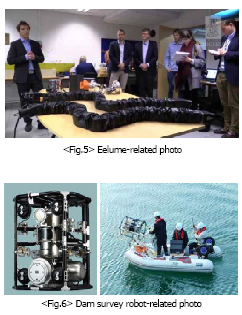
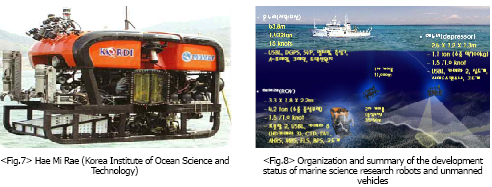
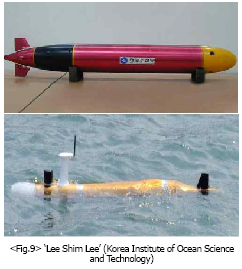
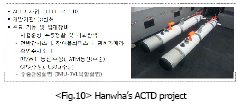
③ Autonomous Underwater Vehicle(AUV) ‘Lee Shim Lee’
The ‘Lee Shim Lee’ is a shallow water AUV developed for the purposes of marine resource exploration, investigating underwater pollution, detailed topographical mapping, as well as investigating underwater objects. It is 0.2m wide, 1.58m long, and weighs 38kg. It can be autonomously operated up to depths of 100m through the sensor attached to the main body. Whilst developing the ‘Lee Shim Lee’, the Korea Institute of Ocean Science and Technology developed an underwater docking technique by installing a camera to the bow so that it can find its own way to the docking station. Currently, it is only able to dock in current-free environments with good visibility. The next stage of docking method research will attempt to incorporate the use magnetic fields or ultrasonic waves.
On the other hand, Hanwha, through its Advanced Concept Technology Demonstration(ACTD) project, has utilized this technology to develop an AUV for underwater reconnaissance. Its main functions and equipment are shown in Figure 10.
④ Multi-jointed composite underwater robot, Crabster ‘CR200’
The CR200 was developed to work in environments, like Korea’s West Coast, where the current is strong and visibility is bad. The Crabster ‘CR200’ is 2.4m long, 2.4m wide, 1.3m high, weighs 700kg and can descend up to 200m. It is also advantageous in that, despite being in strong currents of up to 2 knots, it is able to check a location as well as seabed conditions in order to retrieve samples. The ‘CR200’ has six feet, the two front feet serve a dual purpose which can be used as arms when necessary and when the legs are not on the seabed, the arms act as wings to help swim around.
The Crabster ‘CR200” was used in the rescue support efforts of the Saewol. It used underwater sound waves from 70m in front of the ship to identify how the ship lay on the seabed as well as distinguish the surrounding environment and objects. In April 2015, it was also involved in exploring the seabed under the vessel.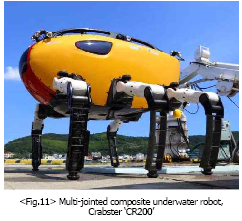
2. Underwater construction robot
Gradually increasing marine infrastructure (marine energy, offshore plants, etc.) has grown the need for marine robots necessary for underwater construction and maintenance. Current methods, which rely heavily on divers, not only pose a risk to the divers, but it is also inefficient in that divers can only work in shallow waters up to 20m. On the other hand, not only are underwater construction robots more efficient and able to work in deeper depths, they also help reduce risk for divers.
Underwater robots can be used in a variety of situations such as construction, relief and rescue, exploration, etc. In relation to construction, robots can be used at different stages of the construction process from using mapping to identify the terrain, installation, construction, maintenance as well as disassembly. In particular, as drying work is substantial and involved lots of heavy-lifting, the WROV is used in jobs such as cabling.
Korea established its inaugural Underwater Construction Robotics R&D Center(UCRC) in 2013. Prior to that, as there was minimal demand for construction, underwater exploitation, investigation, and mining activities were limited. The UCRC plans to commercialize and source technology development in 2018.
On examination of the different types of construction robots, underwater excavators, seabed coring, sampling, and surveying robots; robots that move around surveying harbor facilities whilst crawling on walls also exist.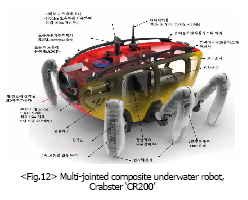

① Shallow water excavator ‘UX-100’
In order to install large, offshore structures on the seabed, the ‘UX-100’ can be used and controlled remotely instead of using diver’s, thus shortening the work period and ensuring worker safety. ‘UX-100’s technology consists of underwater construction equipment, onboard support systems, and a remote operation facility. The ‘UX-100’ is designed and manufactured with special waterproofing and is driven by the hydraulic pressure generated by the power supplied from the ship. The onboard support system consists of a generator and a cable winch. The remote operation facility is equipped with various sensors and the ability to cumulate sonar data to visualize the work area and make adjustments to the equipment based on the collected data. The ‘UX-100’ has the advantage of being able to work reliably under high water pressure and also minimizing on-land worker’s equipment and system coordination training. In particular, the virtual imagery system has the advantage of visualizing underwater operation areas with no visibility. 
- The unmanned mechanized underwater excavation and rock picking equipment can be operated by underwater remote control
- Underwater environment monitoring system for underwater object recognition and underwater location analysis
- Remote control operated system can be used for unmanned and mechanized underwater construction
② Shallow water drilling robot ‘DrillBot-100’
‘DrillBot-100’ is a seabed surveying equipment which can be remotely controlled by placing on the seabed. It can carry out excavations at depths of 50 to 100m as well as collecting samples. 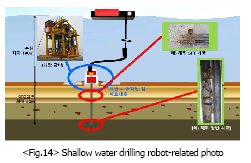
3. Defence Force Unmanned Marine System
The Defence Force Unmanned Marine System is an autonomous, motion-powered-body system capable of carrying out missions in various marine environments including under and on water as well as mid air operations. This system is inclusive of Underwater Unmanned Vehicle(UUV), Remotely Operated(Underwater) Vehicle(ROV), and Unmanned (Water) Surface Vehicle(USV). The Defence Force Unmanned Marine System is capable of carrying out surveillance, mine clearing, anti-submarine, and anti-ship missions to improve the survivability and combat-ability of coastal forces as well as expanding operational areas.
The advantages of the Defence Force Unmanned Marine System are as follow: 1) It is possible to perform simple and repetitive missions in dangerous and polluted waters to minimize damage to human lives and expand combat power to difficult operational areas. 2) It can be a countermeasure against asymmetric and unconventional warfare. 3) It can be a key component for the groundwork of cooperative engagement in future war environments. 4) Acquisition and operation costs are relatively lower compared to manned systems. In other words, the Defence Force Unmanned Marine System enhances survivability and combat-ability of manned systems and serves the purpose of expanding operational areas.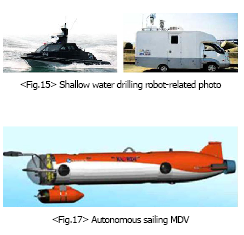
(1) Development status of the Defence Force Unmanned Marine technology
① Development Status of USVs
Industry and Research Institute collaboration: Survey of mine sweepers and other USVs(analysis of USV development trends/ checking USV mine sweeping equipment/ investigating possibility of domestic USV development and recommendations for development direction), development of remote control USV technology, development of complex mission USV technology(development of common platform mission module technology/ development of remote control management USV technology/ development of the groundwork for COLREG autonomous sailing technology/ development of USV mission module linkage technology) 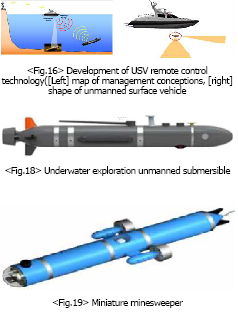
② Development status of UUV
Industry and Research Institute collaboration: related research foundations(submersible body specialization research center/ Defence force unmanned specialization research center/ underwater communications and detection specialization research center), autonomous sailing mine disposal vehicle(MDV) research(minesweeping-use, compact-class UUV, ACTD enterprise/ mass-production preparation), miniature minesweeper(minesweeping, miniature mine-removal UUV, ACTD enterprise/ in the process of military-use practicality performance evaluation)
Agency of Defence Development: SAS load submersible-use UUV concept research(anti-submarine-use, SAS load purpose UUV technology analysis), anti-submarine USV concept research(anit-submarine USV design outline/ anti-submarine USV function concept(inside) suggestion/ energy source and detection sensor demand specifications and development possibility analysis)
(2) Defence Force Unmanned Marine System development strategy
The Defence Force Unmanned Marine System will be developed as an unmanned combat surveillance and reconnaissance vehicle. It will go from a fully autonomous to a remotely controlled vehicle, and is planned to be developed from a suspicious vessel search and mounting-use to a submarine mounting-use vehicle. Looking at the development direction of the USV, from 2010 – 2019, it is expected to secure basis technology for complete remote control; 2020 to the mid-20s, an 11m vehicle detection-use technology development is planned; mid-20s, development of a vehicle upwards of 11m; and by the late 2030s, a progression towards a completely autonomous military-use USV is expected.
It will be the same of UUVs. From 2010 – 2019, basis technology will be secured; 2020 to mid-2020s, suspicious vessel mounting technology will be developed; around the late-2020s, submarine mounting technology will be developed; and by the 2030s, a progression towards military-use control as well as the possibility of communication-use, multi-mission cooperation is expected.
Specific strategies for technology development are: 1) transitioning from a platform-based design to a mission-based design, 2) priority development of unmanned systems to carryout missions in preparation of pre-existing threats, and 3) share the Industry and Research Institute’s role’s load by actively utilizing the institute’s technology. 4) Future progression from a sole developer of an unmanned mission system to a jointly developed manned/unmanned mission system, 5) planned proposal for long-term independence strengthening of technology development from manned vehicles to unmanned vehicles.



